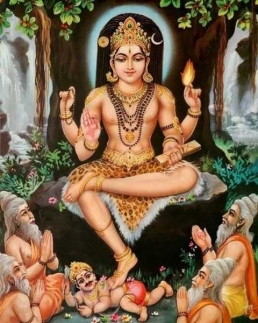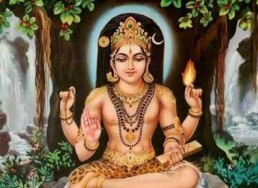Dakshinamurthy Stotram
ॐ मौनव्याख्या प्रकटितपरब्रह्मतत्वंयुवानं
वर्शिष्ठान्तेवसदृषिगणैरावृतं ब्रह्मनिष्ठैः |
आचार्येन्द्रं करकलित चिन्मुद्रमानन्दमूर्तिं
स्वात्मरामं मुदितवदनं दक्षिणामूर्तिमीडे ‖
varśiṣṭhānte vasad ṛṣigaṇair āvṛtaṃ brahmaniṣṭhaiḥ |
ācāryendraṃ karakalita cinmudram ānandamūrtiṃ
svātmarāmaṃ muditavadanaṃ dakṣiṇāmūrtimīḍe ‖
सकलमुनिजनानां ज्ञानदातारमारात् |
त्रिभुवनगुरुमीशं दक्षिणामूर्तिदेवं
जननमरणदुःखच्छेद दक्षं नमामि ‖
sakalamunijanānāṃ jñānadātāramārāt |
tribhuvana guru mīśaṃ dakṣiṇāmūrtidevaṃ
janana maraṇa duḥkha cchedadakṣaṃ namāmi ‖
गुरोस्तु मौनव्याख्यानं शिष्यास्तुच्छिन्नसंशयाः ‖
gurostu maunavyākhyānaṃ śiṣyās tu chinna saṃśayāḥ ‖
गुरवे सर्वलोकानां दक्षिणामूर्तये नमः ‖
gurave sarvalokānāṃ dakṣiṇāmūrtaye namaḥ ‖
निर्मलाय प्रशान्ताय दक्षिणामूर्तये नमः ‖
nirmalāya praśāntāya dakṣiṇāmūrtaye namaḥ ‖
सच्चिदानन्द रूपाय दक्षिणामूर्तये नमः ‖
saccidānanda rūpāya dakṣiṇāmūrtaye namaḥ ‖
व्योमवद् व्याप्तदेहाय दक्षिणामूर्तये नमः ‖
vyomavad vyāptadehāya dakṣiṇāmūrtaye namaḥ ‖
विश्वं दर्पणदृश्यमाननगरी तुल्यं निजान्तर्गतं
पश्यन्नात्मनि मायया बहिरिवोद्भूतं यथा निद्रया।
यः साक्षात्कुरुते प्रबोधसमये स्वात्मानमेवाद्वयं
तस्मै श्रीगुरुमूर्तये नम इदं श्रीदक्षिणामूर्तये ॥ १॥
paśyannātmani māyayā bahirivodbhūtaṃ yathā nidrayā.
yaḥ sākṣātkurute prabodhasamaye svātmānamevādvayaṃ
tasmai śrīgurumūrtaye nama idaṃ śrīdakṣiṇāmūrtaye .. 1..
मायाकल्पितदेशकालकलनावैचित्र्यचित्रीकृतम् ।
मायावीव विजृम्भयत्यपि महायोगीव यः स्वेच्छया
तस्मै श्रीगुरुमूर्तये नम इदं श्रीदक्षिणामूर्तये ॥ २॥
māyākalpitadeśakālakalanāvaicitryacitrīkṛtam .
māyāvīva vijṛmbhayatyapi mahāyogīva yaḥ svecchayā
tasmai śrīgurumūrtaye nama idaṃ śrīdakṣiṇāmūrtaye .. 2..
साक्षात्तत्त्वमसीति वेदवचसा यो बोधयत्याश्रितान् ।
यत्साक्षात्करणाद्भवेन्न पुनरावृत्तिर्भवाम्भोनिधौ
तस्मै श्रीगुरुमूर्तये नम इदं श्रीदक्षिणामूर्तये ॥ ३॥
sākṣāt tat-tvam-asīti veda vacasā yo bodhayaty āśritān .
yat sākṣāt karaṇād bhaven na punar āvṛttir bhavām bho nidhau
tasmai śrī gurumūrtaye nama idaṃ śrī dakṣiṇāmūrtaye .. 3..
ज्ञानं यस्य तु चक्षुरादिकरणद्वारा बहिः स्पन्दते ।
जानामीति तमेव भान्तमनुभात्येतत्समस्तं जगत्
तस्मै श्रीगुरुमूर्तये नम इदं श्रीदक्षिणामूर्तये ॥ ४॥
jñānaṃ yasya tu cakṣur ādi karaṇa dvārā bahiḥ spandate .
jānāmīti tameva bhāntam anubhāty etat samastaṃ jagat
tasmai śrī gurumūrtaye nama idaṃ śrī dakṣiṇāmūrtaye .. 4..
स्त्रीबालान्धजडोपमास्त्वहमिति भ्रान्ता भृशं वादिनः ।
मायाशक्ति विलास कल्पितमहा व्यामोहसंहारिणे
तस्मै श्रीगुरुमूर्तये नम इदं श्रीदक्षिणामूर्तये ॥ ५॥
strī bāla-andha jaḍo pamāstvaham iti bhrāntā bhṛśaṃ vādinaḥ .
māyā śaktivilāsa kalpitamahā vyāmoha saṃhāriṇe
tasmai śrī gurumūrtaye nama idaṃ śrī dakṣiṇāmūrtaye .. 5..
सन्मात्रः करणोपसंहरणतो योऽभूत्सुषुप्तः पुमान् ।
प्रागस्वाप्समिति प्रबोधसमये यः प्रत्यभिज्ञायते
तस्मै श्रीगुरुमूर्तये नम इदं श्रीदक्षिणामूर्तये ॥ ६॥
sanmātraḥ karaṇopasaṃharaṇato yo’bhūt suṣuptaḥ pumān .
prāgasvāpsamiti prabodhasamaye yaḥ pratyabhijñāyate
tasmai śrī gurumūrtaye nama idaṃ śrīd akṣiṇāmūrtaye .. 6..
व्यावृत्तास्वनुवर्तमानमहमित्यन्तः स्फुरन्तं सदा ।
स्वात्मानं प्रकटीकरोति भजतां यो मुद्रया भद्रया
तस्मै श्रीगुरुमूर्तये नम इदं श्रीदक्षिणामूर्तये ॥ ७॥
vyāvṛttāsv anuvartamānam aham ity antaḥ sphurantaṃ sadā .
svātmānaṃ prakaṭīkaroti bhajatāṃ yo mudrayā bhadrayā
tasmai śrī gurumūrtaye nama idaṃ śrī dakṣiṇāmūrtaye .. 7..
शिष्याचार्यतया तथैव पितृपुत्राद्यात्मना भेदतः ।
स्वप्ने जाग्रति वा य एष पुरुषो मायापरिभ्रामितः
तस्मै श्रीगुरुमूर्तये नम इदं श्रीदक्षिणामूर्तये ॥ ८॥
śiṣyācāryatayā tathaiva pitṛputrādyātmanā bhedataḥ .
svapne jāgrati vā ya eṣa puruṣo māyāparibhrāmitaḥ
tasmai śrī gurumūrtaye nama idaṃ śrī dakṣiṇāmūrtaye .. 8..
इत्याभाति चराचरात्मकमिदं यस्यैव मूर्त्यष्टकम् ।
नान्यत्किञ्चन विद्यते विमृशतां यस्मात्परस्माद्विभोः
तस्मै श्रीगुरुमूर्तये नम इदं श्रीदक्षिणामूर्तये ॥ ९॥
ityābhāti carācara ātmakamidaṃ yasyaiva mūrtyaṣṭakam .
nānyat kiñcana vidyate vimṛśatāṃ yasmāt parasmād vibhoḥ
tasmai śrī gurumūrtaye nama idaṃ śrī dakṣiṇāmūrtaye .. 9..
तेनास्य श्रवणात्तदर्थमननाद्ध्यानाच्च सङ्कीर्तनात् ।
सर्वात्मत्वमहाविभूतिसहितं स्यादीश्वरत्वं स्वतः
सिद्ध्येत्तत्पुनरष्टधा परिणतं चैश्वर्यमव्याहतम् ॥ १०॥
tenāsya śravaṇāt tadartha mananād dhyānād ca saṅkīrtanāt .
sarvātmatva mahā vibhūti sahitaṃ syād īśvaratvaṃ svataḥ
siddhyet tat punar aṣṭadhā pariṇataṃ ca iśvaryam avyāhatam .. 10..

Description
Dakshinamurti is an incarnation of Shiva, the supreme god of knowledge. Dakshinamurti is an aspect of Shiva as the original Guru of all types of knowledge, and bestower of jnana. This aspect of Shiva is his personification as the supreme or the ultimate awareness, understanding and knowledge.
The Dakshinamurti Stotra is a Sanskrit religious hymn to Shiva by Sri Adi Shankaracharya. It explains the metaphysics of the universe in the frame of the tradition of Advaita Vedanta. In the Hindu mythology, Dakshinamurti is an incarnation of Shiva, the supreme god of knowledge. Repeated chanting and/or meditating on the meaning of these verses is expected to help a spiritual practitioner of Advaita vedanta get thoroughly established in an Advaitic experience.
Here is a link to the PDF of a book on Dakshinmurthy Stotram and the commentary (Vārtikam) upon these ten stanzas by Sankara’s great disciple Śrī Sureśvarācārya. This commentary is entitled as “Mānasollāsa” (That which exhilirates the mind). To view this PDF click here.
For a detailed explanation of each verse and commentary please read Swami Paramarthananda’s detailed lectures here.
INTRODUCTION TO SRI DAKSHINAMURTHY STOTRA
By Swami Chinmayananda
Of all the hymns of Śrī Śankara, Śrī Dakşiņāmūrty Stotra is the shortest but, at the same time, in its philosophic import, subtlety of expression and confident assertion, it is one of the most inspired works of the advaita philosopher. On a small canvas, Śankara has with unerring dexterity crammed all the arguments of the non-dualist against the preachers of dualism. Naturally, the stanzas are loaded with suggestions, and to dive into their rich depths, special training is necessary for the students.
In short, these stanzas are not lessons addressed to new initiates, but they are discussions with students who have already fully studied the śāstras and are now ready to enter into their meditation seats. A strict pattern of thought development is observed in these ten stanzas which are linked together into one monumental garland of philosophical thoughts, based on the declarations of the rșis of the upanişads.
The opening Stanza, while indicating the pluralistic world of perceptions, shows how they are all the play of the one infinite Reality and it insists that to realise this Truth, through the help of a proper teacher, is to gain the ultimate goal of human existence.
The following two Stanzas describe how the perception of the false—a world of delusive forms and names superimposed upon the infinite ever-present reality-has come about.
Stanzas 3 and 4 explain the methods by which this misapprehension of the Reality can be ended and also describes how the light of the infinite expresses itself from within each one of us through the vehicles of perception.
Stanza 5 indicates how this delusory power of māyā confuses some great students of the upanişads and even greater thinkers and philosophers.
Stanza 6 focuses our attention upon our own experiences in life. It indicates the methods by which, through a scientific analysis of our own vivid experiences in the three planes of consciousness—waking, dream and deep sleep-we can easily come to realise that the reality behind our individual personalities is the reality behind the entire universe.
Stanza 7 points out what is the fathomless substratum upon which alone, is reflected, the play of change that dances to the tune of finitude and sorrow.
Stanza 8 answers the material scientists and the secular observers of the world, who consider the world as real because it is constantly yielding to them definite sets of experiences.
In Stanza 9, the usual technique of upāsanā is prescribed for those diligent students who, even after a deep and careful study of the previous stanzas, are not able to fully appreciate the import of them all. Lack of integration within will make students unfit for such subtle flights to the lofty heights of vedānta, when it discusses the ultimate theme. To help them gain the necessary integration, this stanza prescribes an upāsanā .
The concluding Stanza states that these are not ideas to be merely heard or understood, but that each student should reflect upon them and make them his own. It also explains how, as a result of this education, each one of us can achieve an unfoldment of his or her own personality to a diviner dimension and to the eventual attainment of “liberation”.
These stanzas have unsuspected depths, though superficially they have a simple and direct meaning. Every phrase that is used in them has a definite purpose and it is lined up against an army of opponents who believe and argue against the conclusions of the vedāntik philosophy. Thus the samkhyanas, the vaiseșikās, the naiyyayikās, the cārvakās, the Buddhists…..not to mention different minor groups….all come under the annihilating intellectual fire of Ācārya Sankara in these discussions. Here we meet not only Śankara, the devotee, but we discover Sankara, the disputant and Sankara, the champion of the advaita philosophy, armed to the teeth, fighting against all misconceptions, illogical arguments and hasty conclusions…… alien to the spirit and letter of the upanișadik declarations.
These ten Stanzas are a summary of the arguments in the upanişads, of the declarations in the Brahma sūtras and of the Gitā.
The upanișadik declaration, “Brahman alone is the reality; the world-of-change is a delusion” (ब्रह्म सत्यं जगन्मिथ्या जीवो ब्रह्मैव नापरः। Brahma Satyam Jagan-mithyā Jivo Brahmaiva Nāparaḥ) is the theme that is taken up here in these ten stanzas by Ācārya Sankara and he elucidates its subtle imports with a philosophical scholarship, tempered by kindness towards those who cannot directly understand the deeper suggestion of the upanișadik thought.
As it stands today, we have a commentary (Vārtikam) upon these ten stanzas by Sankara’s great disciple Śrī Sureśvarācārya. This is entitled as “Mānasollāsa”. (To read this further, please purchase the book using the link below.)
The meaning of Dakshinamurthy
Lord Siva, in order to instruct the rishis and the seers assumed the form of a Guru, and sitting on the peak of Kailasa, He turned southward to serve all seekers. In the Upanishad we read the explanation of the term Dakshinamurthy. The term dakshina means “that divine power of subtle perception which is generated in a fully integrated pure intellect.” This dakshina power when flowing towards (kshane mukham), the vasana-conditioned hearts of the disciples (yasyam) is called “turned-southward” and this is Siva, say the champions of reality (Brahma-vaadibhih). So, the Teacher is none other than the Supreme, who has manifested himself in the divine form of Sri Dakshinamurthy to bless the struggling aspirant. He is invoked here for our devoted worship.
Other Dakshinamurthy Shlokams
Ishvaro Guru Atmeti
Shlokams,Shiva,Dakshinamurthy,Guru,Sankara
Salutations to Lord Dakshinamurti, who is all-pervasive like space but who appears (as though) divided as Lord, Guru, and the Self.
Mauna Vyakhya
Shlokams,Sankara,Shiva,Dakshinamurthy
I salute Sri Dakshinamurti, who is not subject to time, who makes known the truth of Brahman through the implied meaning of words, who is surrounded by disciples who are themselves Rishis and committe
Nidhaye Sarvavidyanam
Shlokams,Sankara,Shiva,Dakshinamurthy
Salutations to Sri Dakshinamurti, the reservoir of knowledge (the abode of all learning), the healer of all those who suffer from the disease of samsāra, and the teacher of the whole world.
Om Namah Pranavarthaya
Shlokams,Sankara,Shiva,Dakshinamurthy
Om. Salutation to the one who is the meaning of praņava, who is in the form of pure knowledge, who is taintless and who is free from any change. To that Sri Dakshinamurti, (my) salutations.
Om Namo Bhagavate Dakshinamurthaye
Shlokams,Sankara,Shiva,Dakshinamurthy
Om. Salutations to Bhagavan Dakshinamurti. (Oh Lord) Bless me with memory, the capacity to think properly, and clarity, wisdom.
Dakshinamurthy Stotram – Dakshinamurthy – With English Transliteration, Translation and Meaning. Commentary for selected Shlokams.

